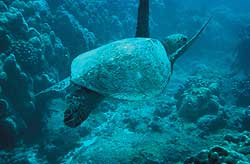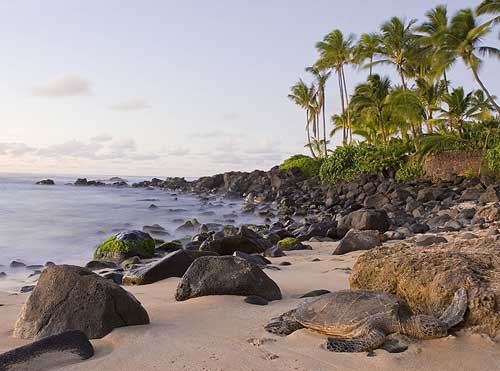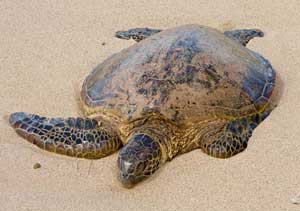The threatened Green Sea Turtle is one of seven species of sea turtles found throughout the world. An adult Green Sea Turtle carapace (top of shell) can measure more than three feet (one meter) in straight carapace length, and weigh 220 pounds (100 kilograms). This species has a smooth carapace with four pairs of lateral scutes (plates), a single pair of prefrontal scales, and a lower jaw-edge that is coarsely serrated, corresponding to strong grooves and ridges on the inner surface of the upper jaw.
The term "green" applies not to the external coloration, but to the color of the turtle's subdermal fat. The carapace of adult Green Sea Turtles is light to dark brown, sometimes shaded with olive, with radiating wavy or mottled markings of a darker color or with large blotches of dark brown.
 |
| Green Sea Turtle. (Courtesy U.S. Fish and Wildlife Service) |
Habitat & Behavior:
The Green Sea Turtle is found world wide in warm seas. In the Pacific United States (U.S.) and its territories, Green Sea Turtles are found along the coasts of Hawai`i, American Samoa, Guam, the Commonwealth of the Northern Mariana Islands (CNMI), unincorporated U.S. island possessions, and a small resident group in San Diego Bay, California. Individuals may occasionally be found as far north as Alaska.The Green Sea Turtle occupies three habitat types: open beaches, open sea, and feeding grounds in shallow, protected waters. Upon hatching, the young turtles crawl from the beach to the open ocean. When their shells grow 8-10 inches long, they move to shallow feeding grounds in lagoons, bays, and estuaries. They graze in pastures of sea grasses or algae but may also feed over coral reefs and rocky bottoms. Young Green Sea Turtles are omnivorous (eating both animal and plant matter), adults are vegetarians. Growth rates seem to vary depending on where the turtles live.
 |
| A Green Sea Turtle in its environment - North Shore of Oahu. |
In Hawai`i, nesting occurs throughout the Hawaiian archipelago, but over 90 percent occurs at the French Frigate Shoals in the northwestern Hawaiian Islands. Approximately 200-700 females are estimated to nest annually. Lower level nesting occurs in American Samoa, Guam, CNMI, Laysan Island, Lisianski Island, and Pearl and Hermes Reef.
Past & Present:
Green Sea Turtles and their eggs were once a food source for native Pacific Islanders. The meat, viscera, and eggs supplied a nutritious and succulent alternative to the more common food sources, such as fish, birds, shellfish, coconuts, breadfruit, and taro. The adult female turtles were especially prized due to their large quantities of fat. The utilization of Green Sea Turtles for food and other purposes was often under strict control, usually from some form of island council or tribal chief.Religious, ceremonial, and other traditional restrictions on the capture, killing, distribution, and consumption of Green Sea Turtles played an important role in their utilization. For example, in the Hawaiian Islands there were families that considered the Green Sea Turtle to be a personal family deity or "aumakua." Artistic elements of Green Sea Turtles have also been featured prominently in some cultures of the Pacific, such as in petroglyphs and tattoo designs.
Green Sea Turtle populations have declined dramatically in the Pacific islands. Overharvest of turtles and eggs by humans is by far the most serious problem. Other threats include habitat loss, capture in fishing nets, boat collisions, and a disease known as fibropapillomatosis. While this species is declining throughout most of the Pacific, in the Hawaiian Islands, Green Sea Turtles are demonstrating some encouraging signs of population recovery after 17 years of protective efforts.
Conservation Efforts:
Green Sea Turtles are listed as threatened under the U.S. Endangered Species Act (ESA) throughout all areas under U.S. jurisdiction. In the Pacific, the ESA applies to Hawai`i, Guam, CNMI, American Samoa, and the eight unincorporated U.S. islands (Midway, Wake, Johnston, Palmyra, Kingman, Jarvis, Howland, and Baker). Inclusion of Green Sea Turtles into the Convention on International Trade in Endangered Species of Wild Fauna and Flora (CITES) has made it illegal to trade any products made from this species in the U.S. and 130 other countries. The final Recovery Plans for this species were recently completed by the National Marine Fisheries Service and serve as guidance in actions to recover Green Sea Turtles.
